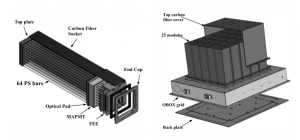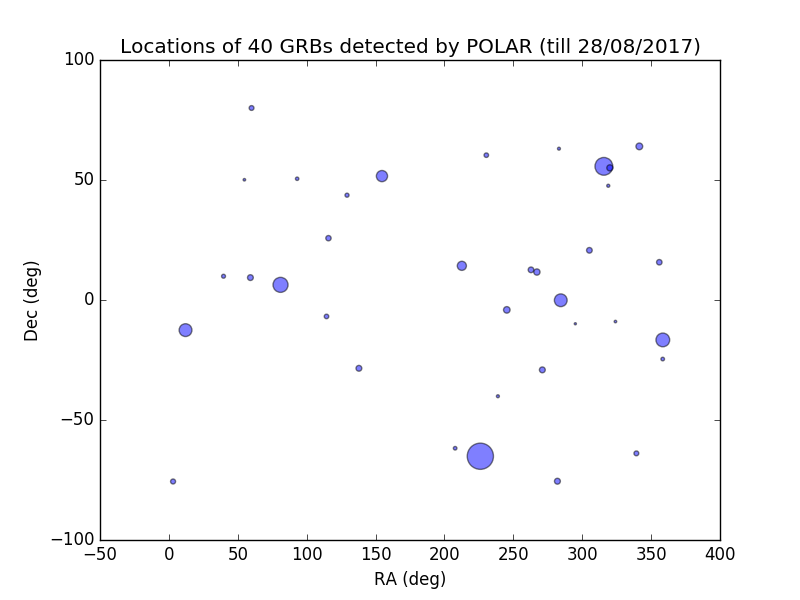The strongest explosions in the Universe, known as Gamma Ray Bursts (GRBs) are associated with the creation of black holes. The structure of magnetic fields and whole dynamics of the event influence polarization of the promptly emitted gamma-rays. Therefore, precise polarization detection can be a definitive tool for the determination of the true GRB emission mechanism.
POLAR is a space-borne Hard-X ray polarimeter built by a collaboration of institutes from Switzerland, China and Poland. It is equipped with an array of 1600 plastic scintillators allowing for precise and efficient measurement of the linear polarization of hard X-rays in the energy range from 50 keV to 500 keV. POLAR’s primary goal is to measure the polarization in the prompt emission from the Gamma Ray Bursts (GRB) – the biggest explosions in the Universe. It is also capable of precise polarization measurements in solar flares.
Instrument features:

- Space-born hard X-ray Compton polarimeter.
- Array of 40 × 40 plastic scintillator bars (each 5.8×5.8×172 mm3 ).
- Bars grouped in 25 modules.
- Each module read-out with its own Multi-anode PMT (MaPMT) and
ASIC based front-end electronics. - Detection principle based on the angular anisotropy in the Compton scattering
of polarized gamma rays described by the Klein-Nishina equation - Polarization calculation based on two largest energy depositions left by each detected hard X-ray photon.
- Launched on the Chinese Spacelab TG-2 on Sept. 15th, 2016.
- Low earth orbit with altitude ~ 380 km
- Anticipated detection rate ~10 strong GRBs / year.
POLAR was successfully launched on-board the Chinese space laboratory Tiangong-2 (TG-2) from the Jiuquan Satellite Launch Center (Inner Mongolia province, China) on September 15th, 2016 at 14:04 UT.
POLAR Space data
Fig. 2 and Fig. 3 show background count rates at different locations and Locations of GRBs detected by POLAR. More information of GRBs detected GRBs is available Here


About PSI POLAR Group


POLAR team at PSI consists of four scientists (Hualin Xiao, Radoslaw Marcinkowski, Ping Zhang and Wojtek Hajdas) one electronics engineer (Reinhold Kramert) and one technician (Ken Egli). It belongs to the Applied Particle Physics and Irradiation group (led by Wojtek Hajdas wojtek.hajdas@psi.ch) being a part of the PSI Laboratory for Particle Physics.
Both the concept of POLAR detection system and its main electronics were developed at APPI. POLAR front-end electronics for signal readout from the modules as well as the central computer boards were fabricated, tested and qualified at PSI. Our team is currently involved in the in-depth studies of the POLAR performance in space as well as in the calibration and analysis of the orbital data. To facilitate more efficient data analysis and serve science communities involved in the Gama Ray Bursts and Solar Flare studies Dr. Hualin Xiao (hualin.xiao@psi.ch) has developed APPI-PSI own POLAR Data Center.
POLAR Collaboration
The following institutes belong to the POLAR collaboration:
- Paul Scherrer Institut (PSI), Villigen, Switzerland
- Institute of High Energy Physics (IHEP), Beijing, China
- INTEGRAL Science Data Centre (ISDC), Geneva, Switzerland
- Département de Physique Nucléaire et Corpusculaire (DPNC), Geneva, Switzerland
- Narodowe Centrum Badań Jądrowych (NCBJ), Świerk, Poland